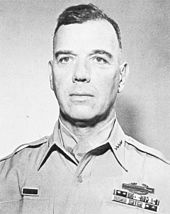90th Infantry Division (United States)
|
90th Infantry Division |
|
|---|---|
 Division badge |
|
| active | 1917, 1942 to 1945 |
| Country |
|
| Armed forces | United States Armed Forces |
| Armed forces | United States Army |
| Branch of service | infantry |
| Type | Infantry division |
| Nickname | Tough 'ombres |
| Butcher | Second World War |
The 90th Infantry Division ( German 90th US Infantry Division ) was a major unit of the US Army in World War I and World War II .
history
First World War
The division was formed in August 1917 and came to France with the American Expeditionary Forces . It was used under Major General Henry T. Allen during the Battle of St. Mihiel in the Pont-à-Mousson area , where it fought against the Germans as part of the I. Corps (General Liggett ). From mid-October 1918 she was in the section of III. Corps deployed in the final phase of the Meuse-Argonne offensive during the advance from Cunel to Bantheville before they invaded Germany after the end of the war. She was there until May 1919 a. a. stationed in Mülheim and Brauneberg . In June 1919 the division was returned to the United States and eventually demobilized. During the operation in Europe 1091 soldiers of the 90th Infantry Division fell in combat and 6458 were wounded.
Second World War
After the USA entered World War II, the 90th Infantry Division was reactivated on March 25, 1942. Less than two years later she was brought to England , where the Allies were preparing for Operation Overlord . On June 6, 1944, D-Day , soldiers of the VII Corps landed on Utah Beach on the Normandy coast . After a bridgehead was formed there, the division fought from June 10th a. a. at Pont-l'Abbé and crossed the Douve . In July there was again heavy fighting against the Wehrmacht in the Foret de Mont-Castre , with 5,000 killed or wounded or taken prisoner on July 11th alone. On July 27, Périers was captured. On August 12, the division formed one of the units of the VIII Corps that closed the Falaise pocket. This was followed by battles for Metz and, until November, the occupation of Maizières-lès-Metz and the Feste Königsmachern . Then followed in the association of XX. Corps made the advance to the Saar , with the 90th Infantry Division taking part in the defensive defense of the Ardennes offensive and, in January 1945, being able to break through the Ardennes with the 94th Infantry Division. According to Peter Schrijvers, the 90th US Infantry Division killed its prisoners from the Waffen SS on the Saar in December 1944 in such a systematic manner that the leadership issued express orders to let prisoners of the Waffen SS live in order to obtain information from to be able to receive them. In February the Siegfried Line was finally broken through with other American associations. Then the Moselle was crossed on 21/22. March March Mainz was occupied without resistance. The city was later handed over to the French. The division then crossed the Rhine , the Main and the Werra . On April 18, parts of the XII. Corps assigned to the 90th Infantry Division crossed the border with Czechoslovakia . On April 23, liberated soldiers of the division with parts of the 97th Infantry Division , the Flossenburg concentration camp , where more than 1,000 prisoners were found. On May 8th, the day the war ended, the division reached Deutschbrod , where the pilot Erich Hartmann with his Jagdgeschwader 52 surrendered. The 90th Infantry Division withdrew from the Czech Republic after the end of the war before being brought back to the USA in December 1945, where it was demobilized on December 27th. During the Second World War, 3,342 soldiers of the division were killed and 14,386 were wounded.
Established in 1995, the 90th Sustainment Brigade continues the tradition of the 90th Infantry Division.
Division commanders
- Maj. Gen. Henry T. Allen (August 25 - November 23, 1917)
- Brigadier General Joseph A. Gaston (November 23 - December 27, 1917)
- Brigadier General WH Johnston (December 27, 1917 - March 1, 1918)
- Maj. Gen. Henry T. Allen (March 1, 1918 - November 24, 1918)
- Brigadier General Joseph P. O'Neil (November 24 - December 30, 1918)
- Major General Charles H. Martin (December 30, 1918 - dissolution)
- Maj. Gen. Henry Terrell Jr. (March 25, 1942 - January 1944)
- Brigadier General Jay W. MacKelvie (January-July 1944)
- Major General Eugene M. Landrum (July - August 1944)
- Maj. Gen. Raymond S. McLain (August - October 1944)
- Major General James A. Van Fleet (October 1944 - February 1945)
- Maj. Gen. Lowell W. Rooks (February - March 1945)
- Major General Herbert L. Earnest (March - November 1945)
Web links
Individual evidence
- ↑ Locations of the division in the First World War
- ↑ Peter Schrijvers: The Crash of Ruin: American Combat Soldiers in Europe During World War II. MacMillan Press, London 1998, pp. 79-80
- ↑ Article on the end of the war in Mainz
- ↑ Entry by the USHMM

